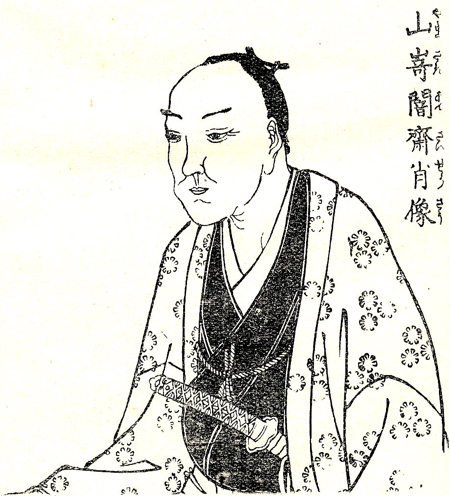
Ansai Yamazaki (1619-1682), founder of Suika Shinto
Ansai Yamazaki and Ama-no-ukihashi-den
Ansai Yamazaki was an Edo Period Confucian scholar who started out as a Buddhist monk and was one of the first people to spread Neo-Confucian thought in Japan.
Interestingly, Zhang San Feng(张三丰), the legendary creator of Tajiquan in China, was also influenced by Neo-Confucian thought.
Yamazaki was also the founder of the Suika Shinto sect, and his work on Shinto theology was instrumental in breaking Shinto thought out from the specialized provenance of the shrines to a more general population. We’ll get back to how this relates to the Floating Bridge a little bit later.
合氣を学ぶものは天の浮橋に立たねばならぬ
In order to learn Aiki you must stand on the Floating Bridge of Heaven.
As you can see from the above quotation, Aikido Founder Morihei Ueshiba seemed to think that the “Floating Bridge of Heaven” (天之浮橋) was a pretty important thing.
Still – for all of its importance in his writings it is a concept that is generally not well understood. A direct student of Morihei Ueshiba O-Sensei once expressed it to me this way:
The Founder told us that we would be unable to practice martial arts if we did not stand on the Floating Bridge of Heaven. We were told that if we could not stand on the Floating Bridge of Heaven then our training would not bring forth Aikido technique, so it was essential that we do so at all costs.
However, we didn’t understand anything about where this Floating Bridge of Heaven was. Since we didn’t understand where it was there was no way that we could stand on it, so the reality was that we just put on a good face and kept on applying techniques to each other.
If you’ve read “Aikido and the Unknown” then you may have some idea why this kind of thing is not well understood, but just in case, here’s an interesting passage from Koichi Tohei (from “Ki no Kakuritsu” / 気の確立, translated from the Japanese):
Without a doubt, Ueshiba Sensei understood Ki. If we’re talking about that point, then I think that you could say that he was a genius. However, it is unfortunate that he never taught the true nature of it to his students. Even now I don’t know if that was because he didn’t want to teach it, or if it was because he was unable to teach it.
You may also like to take a look at “Morihei Ueshiba: Untranslatable Words” for an interesting story about Koichi Tohei himself and understanding of O-Sensei.

Koichi Tohei with Hawaiian born sumo wrestler Jesse James Wailani Kuhaulua (Takamiyama). The text on the left reads: “The author taught Ki to Takamiyama (the Hawaiian born sumo wrestler) after being asked to help by one of his students in Hawaii, and that tournament saw the first victory ever for a foreign born sumo wrestler in the Makunouchi division. However, he was reprimanded by the stable master for studying an art other than sumo and could not continue.”
In any case, at this point you may want to take a moment to go back and look at the previous article “Aikido and the Floating Bridge of Heaven“, if you haven’t read it already, for some background on the structure of this training model.
Now…back to the Floating Bridge.
Here’s an interesting passage from an article by Yutaka Shimizu that appeared in Aikido Magazine (合氣道マガジン). Shimizu is a Bagua and Taiji instructor in Japan who has also trained in Aikido and Daito-ryu – he has published a number of interesting books in Japanese about Morihei Ueshiba.
「天の浮橋に立つ」とは、神道神学上は特別な意味を持っているのである。江戸時代の儒学者・山崎闇斎は垂加(すいか)神道を創始したが、その秘伝の一つに「天浮橋之伝」がある。それによれば「天浮橋」とは、不通を通ずる義、陰陽感通の処を云、橋箸端よみ通ず、上に立つとは、陰陽共にきっと立て感通するを云うなり、とある。つまり、陰陽というような本来対立して融合することのない二つの要素を融合させる。それが「天の浮橋に立つ」ということの本義なのである。
“Stand on the Floating Bridge of Heaven” has a special meaning in Shinto theology. Suika Shinto was founded by the Edo Period Confucian scholar Ansai Yamazaki, and one of the secret traditions of that school is “The Transmission of the Floating Bridge of Heaven”. According to that tradition, it is written that the meaning of the “Floating Bridge of Heaven” is to open the impassable, to transmit the concept of In and Yo – to stand with In and Yo together. In other words, to reconcile two elements that are intrinsically opposed and un-combinable. This is the true meaning of “standing on the Floating Bridge of Heaven”.
Remember “Aiki Budo is the Way of Human Development“? In that article a scroll from Yukiyoshi Sagawa’s dojo appeared – I noted there that I translated “融和” as “reconciliation” in the text of the scroll. The sense of this, in my reading, is the bringing together of two opposites, and it is in this sense that I used “reconciliation”. In the passage quoted above from Yutaka Shimizu the same Kanji are translated again as “reconcile” – again, the bringing together of two opposites.
If you’ve read the articles noted above, then you should be familiar with Heaven-Earth-Man, In and Yo (Yin and Yang) and the opposing forces being referred to. There is also some slightly more technical discussion of opposing force pairs in “Morihei Ueshiba, Budo and Kamae – Part 3“.
For now lets get back to this quotation from Morihei Ueshiba, which was also cited in the first Floating Bridge article:
左手は伊耶那岐、右手は伊耶那美、真中は天之御中主(あめのみなかぬし)、これは自分のことである。天の浮橋に立たされて、螺旋状にめぐることである。これを高天原(たかあまはら)という。天も地も一つのもの、水も火も一つのもの、みんな息から現れるのである。神の常動の現れである。合気の技は常動により出てくるのである。
The left hand is Izanagi, the right is Izanami, in the center is Ame-no-minakanushi, this is yourself. This is standing on the Floating Bridge of Heaven and turning in a spiral. This is called Taka-ama-hara. Heaven and earth are one unit, water and fire are also one unit, all appears through Iki (breath). This is the endless appearance of the Kami. Aiki technique comes forth endlessly.
Here you can see that Ueshiba clearly delineates the combined opposing In-Yo forces, represented by Izanagi and Izanami.
You can also see that he cites the two basic forces in the body – fire and water. These are so basic to the model that Ueshiba would often write “God” (“Kami”) as a combination of these two characters – fire (Ka) and water (Mi) (火水, Kan and Li in Chinese).
These are the two basic forces in the body in Chinese internal martial arts – along with Heaven and Earth they form the four cardinal directions in Taiji, which are mapped to the four basic Jin (勁) energies of Peng (掤 / wardoff), Lu (履 / rollback), Ji (擠 / press), An (按 / push).
This basic arrangement of Heaven and Earth, In and Yo, Fire and Water was described in “Morihei Ueshiba and the Way of the Cross“.
I’d like to note here that once again he states that this model is essential for the production of Aiki technique.
Now, let’s look at who’s standing on the Bridge, and where they’re standing.
As stated previously, Ame-no-minakanushi represents the “Boss”, the person in charge – and Ueshiba states that this person is you, yourself.
If you are standing in the center, and In and Yo are spiraling around you, then this process must represent something that is happening in yourself, that is being created within yourself. I make the distinction because this is a very different thing than a process that occurs between yourself and another person.
This brings us back to a telling quote from Koichi Tohei’s book “気の確立” (“The Establishment of Ki”), previously cited in “Aikido and the Structure of the Universe“. It comes in the section where he discusses his break from the Aikikai:
二代道主は、合氣道を「人の気に合わせるの道」と解釈していた。しかし私にしてみれば、合氣道とは「心身を統一して天地と一体になる。すなわち天地の気に合わす道」なのである。
The second Doshu interpreted Aikido as “the Way of fitting in with another person’s Ki”. However, it seems to me that Aikido is “Uniting body and mind and becoming one with heaven and earth. Specifically, the Way of fitting together the Ki of heaven and earth.”.
I don’t want to get into whether his characterization of Kisshomaru Ueshiba’s interpretation is accurate or not, but what I will say here is that Tohei’s interpretation of the process as something occurs within yourself is, in my opinion, correct, and that this is indeed a critical point.
So – we have you, the “Boss” standing on the Bridge, but where are you standing?
If you are standing in the “center”, then you are standing between In and Yo – two opposing forces that are constantly cycling and shifting. The point at which they unite and divide from one to the other is the point of change, the neutral point (usually represented by the curving or spiral line in the Taiji symbol).
The only really stable position or “stance” from which to operate is on is this neutral point, which is itself constantly shifting – or we might even say…“Floating”.
Christopher Li – Honolulu, HI
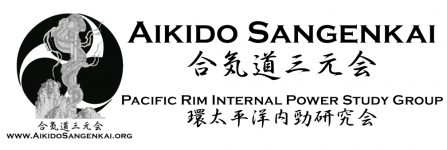
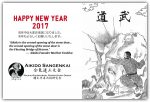


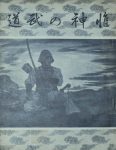

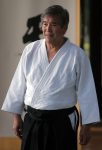
Is it not that the floating bridge is a mathaphor. Shouls one not question what is ‘you’ before one can stand on the floating bridge. I’ m not a regular reader and not aware of al of your explorations in the sayings of o seinsei. But is de sporaliing of the opposite forcing, the combining of these forces what is ‘ creating’ the ‘ you’. Is the possition on the bridge not connected with a oppeness of what ‘ you’ is, or will become?
I know this is a few years old, however, The Floating Bridge of Heaven, can’t be taught, but one can learned, if a person has a open mind and heart. If a person studies Martial Arts for the sake of earning the Black Belt or to show one intellectually knows Technique, then your mind is not able to grasp this concept as a state of being. Read up on “Mushin” or practice Zen Meditation and check out The Book of Five Rings, especially the Book on No-Nothing or No Nothingness. Not everyone will ever experience Ki, because their reason for taking Aikido or any Martial Arts is for the wrong reasons…Therefore, The Floating Bridge of Heaven is not intellectual, but is Spiritual and not Intellectual Spiritual. As a Christian I know what it’s like to be filled with the Spirit, not the Same as Buddhism, yet I have experienced Ki on several occasions, where my practice on the Mat have been in what we call, Aikido Flow….the mind is empty, no feelings of anxiety, hate, mistrust, feeling better than others, no worry, pain, judgement, on concept of time, space. The mind is void of all negative human emotions, wherefore you are in that moment. You are neither tired nor out of breath, because all your breath and strength comes from the person your practicing with…Awesome Feeling!
A more down to earth expression of Tohei’s view of Ki is one that he used very often in his writing and descriptions of Ki: the unification or coordination of mind and body. While it fairly easy to represent Tohei and Kisshomaru Ueshiba as being at odds with one another, I would be grateful if someone could explain why unifying one’s own mind and body precludes or excludes “fitting in” with the Ki of another person. After all, one of Tohei’s main principles for the practice of Aikido was “respect your partner’s Ki.” Furthermore, the capacity of “fitting in with another person’s Ki” would presuppose the existence of Ki within practise – the ability to develop, extend and harmonise Ki. There is a degree of irony in an article about the unification of opposites that presents two leading figures in Aikido history as being doctrinally opposed to one another. Having viewed film of Tohei and Kisshomaru Ueshiba training together I would have to ask how they managed? I suspect their differences were political in origin, and very little to do with fundamental principles. Or is the way of unification just fraught with contention and division?
Hi Alister,
Well, I certainly think that it’s possible for people to have technical differences of opinion and disagreements as to approach while still working together and remaining friendly. Unfortunately, Tohei and Kisshomaru were unable to, though.
Best,
Chris